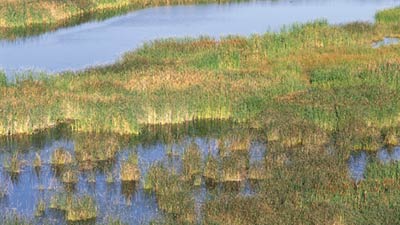|
|
By Mark Turner There are a variety of wetland plants in the New Point Comfort area but the most productive from an ecological standpoint are the plants of the salt marsh. A salt marsh is a transitional zone between land and water, occurring along the intertidal shore. The salinity and frequency of flooding determines the type of animals and plants found there.
Among the most important members of the salt marsh community are the cordgrasses. The regularly flooded low marsh contains mainly smooth cordgrass (spartina alterniflora). This plant is adapted to daily exposure of salt water by having narrow tough blades and special glands that enable it to secrete excess salt. Its stalks are thick and tough and well anchored by a root system. In the area just above the high tide mark is found the high marsh that has saltmeadow cordgrass (spartina patens), salt reed grass (spartina cynosuroides), and a short form of smooth cordgrass (spartina pectinata). The high marsh area is flooded on spring tides and storms.
These plants provide a major source of nourishment to the marine environment once they die. The decaying plant matter, or detritus, is washed into water by waves and settles in the mud flats and sediments. Here it is broken down by microscopic organisms, and provides an important food supply for bottom dwelling scavengers such as worms, fishes, shrimp and crabs. So in that way these plants are a basic ingredient in the marine food web.
Because of the more extensive rate of flushing in the zone below mean high water, spartina alterniflora provides the greatest nutritive input into the food web. In addition, the seeds of the cordgrass plants are an important food source for ducks, geese and shore and song birds. The roots and stems are eaten by both muskrats and deer. Many animals and plants live on the plant itself or on the marsh surface protected by its roots and stalks. These plants are also important for controlling erosion and storm damage.
There are many other plants that live in the high marsh area. Some examples are saltgrass, saltwort, sea-blite, sea-rocket, sea lavender, goldenrod and water hemp. As one proceeds above the high marsh you enter a transition zone between the salt marsh and the upland border. Plants in this transition zone are shrub-like and consists of marsh elder, and groundsel tree.
|
|
Home | History | Local | Sailing | Fishing | Paddling | Rowing | Nature | Biking | Weather | Navigation | Links | Contact
Us | Shop Copyright © 2006 InterMarket Advertising. All Rights Reserved. |
.gif)

